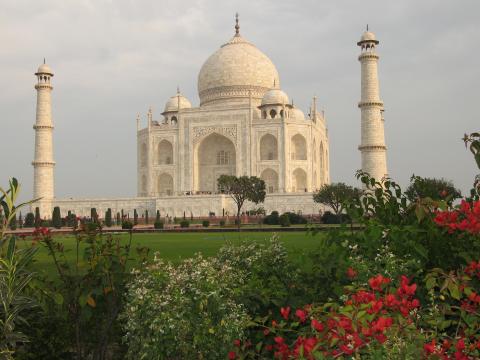
Touring in India in 2007
Tour dates: 23 February - 14 March 2007.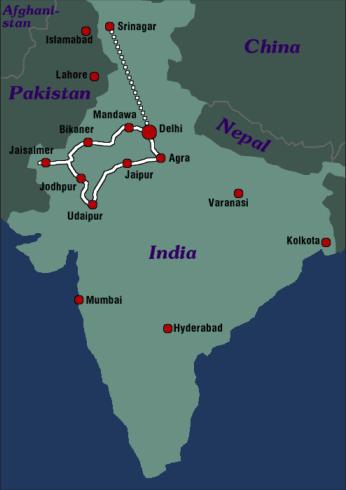
DELHI
24. The Alitalia flight arrived in Delhi 45 minutes early, and we spent that time waiting on the tarmac until the gate was free. Immigration was fast and efficient, and prepaid cabs could be ordered right at the baggage hall exit. The cab driver couldn't find the hotel and took me to a travel agency, which called the hotel and had a voice on the phone tell me that my reservation was invalid, but fortunately the agent had a different room for me despite a convention that fills all available hotel rooms. This reeked of one of the oldest scams on the book, so professionally executed that it was almost charming. But I called the hotel on my cell phone with my own number (GSM coverage is excellent in Rajasthan, and nonexistent in Kashmir) and was told that the story was in fact correct. (Avoid the Metropolis Tourist Home, they don't honor their commitments.) By that time it was after 1:00, so I accepted the agent's offer. I actually slept very well.
The next morning I went back to the agency, after some research on destinations and prices. What followed was a two-hour haggling and planning session to book flights, hotels, and a car with driver. (I don't even drive in Berlin, and traffic in India is madness.) Traveling alone with a car is actually not very cost-effective because you can't split the cost, but India is known for trains and buses packed with people, enormous lines at ticket offices, and uncomfortable roads to the more remote destinations. I ended up with a price that wasn't much higher than the alternative first-class train and bus cost, and it freed my schedule and removed the hassle, delays, and waiting time associated with public transport from my schedule.
In India, higher prices are quoted in euro, lower ones in rupees (one rupee is about two cents). Everyone knows the euro/rupee exchange rate. It's a good idea to bring euro cash; British pounds and US dollars are usually also accepted. Most ATMs work fine with Maestro ATM cards, but villages don't always have ATM machines. Prices in India are about half of what you'd pay in Europe for comparable services, but there is also a whole low-end quality range if you don't mind food stalls, packed public transportation, and dingy hotels.
I prebooked a number of hotels. I usually travel out of season but not this time, so I wanted to be prepared. My recommendation is to visit India in April, when hotels are not a problem and no reservations are necessary, and pick hotels on arrival. In April the temperatures are much higher than the pleasant 25 degrees I had most of the time. I stayed at good hotels, but good hotels are often in inconvenient locations. This was not a problem for me though because I had a driver.
The rest of the day I did a sightseeing tour. I saw the mosque, markets, the Mahatma Gandhi monument, the Bahai Lotus temple (a huge sweeping concrete affair shaped like an enormous tall lotus flower, reminiscent of the Sydney opera), the old British government quarter, and India Gate (a huge arch like an Indian-style Arc de Triomphe in Paris). A good way to see these places, but the tour packed too much into too little time, and we spent way too much time in Delhi's choking honking traffic chaos.
25. In the morning I walked a bit about the local neighborhood. This
is not a rich tourist neighborhood - just a block away from the hotel,
there were many simple hole-in-the-wall stores, dogs digging in garbage
piles, bicycles, those famous green and yellow tuk-tuk motor rickshaws,
and of course cows roaming the street.
SRINAGAR,
KASHMIR
At 9:00 I was picked up and brought to the airport. The terminal looks like an overcrowded bus terminal. After getting lots of security stamps onto my boarding pass and carry-on bag tags - stamps seem to be serious business here - I was off to Srinagar. Landing was odd - the plane glides over villages, and suddenly out of nowhere a hill with a landing strip materializes and the plane touches down. We walked on the runway to an oversized hut with a corrugated metal roof, had to fill out an immigration form (odd, after a domestic flight), and was greeted by the hotel's driver. I was now in Kashmir.
Kashmir is an Indian state at the northern tip of India. It borders on Pakistan, and is a disputed territory that has seen a lot of violence in the 1990s. The Kashmiris are very unhappy about the whole situation and would prefer independence, but neither India nor Pakistan would allow that to happen.
The 2005 Lonely Planet guidebook, in its characteristic candor, describes Srinagar as heavily militarized, with paramilitary troops and sandbag bunkers, and looking like an occupied city. Yes, there are many armed soldiers at the airport and at city intersections, with barbed wire and checkpoints and all that. But I'd seen all that in the Thai Golden Triangle and in Egypt too; only the sandbag bunker was new. Just out of the airport, I heard gunshots but that was just soldiers training.
Srinagar has a beautiful lake, Dal lake, with the snow-capped Himalaya mountain range as a backdrop. At the edge of the lake opposite from the town, a long row of houseboats are awaiting guests. I was staying on the Dandoo palace boat. It's beautiful, all wood-paneled with hand-carved ornate patterns everywhere, carpets, old furniture, and all amenities. Of all the boats I saw from the boat, this one looked like one of the best.
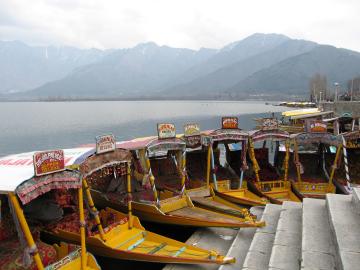
| 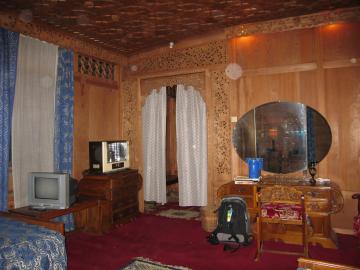
|
| Boats on Dal lake in Srinagar | My room on the houseboat on Dal Lake |
I got a very large room with separate dressing room and bathroom with a tub and hot shower, taking about a quarter of the length of the boat. In the evening I was served a delicious dinner, sitting on a high-backed chair at the head of the table, in the antique-appointed dining room. Tea here is delicious, made with cinnamon, kardamom, safran, and honey, and not bitter at all. The expenses at the travel agent were starting to pay off!
But first, on arrival, we had to finish the formalities, and I wanted to book a short trekking tour in the Himalayas. Again, negotiations took some time and I got the price sufficiently low by identifying and removing unwanted extras, like a sightseeing tour in town. (I have had enough sightseeing in Delhi.) I also got invited for tea at his home behind the boat. My host and a friend ate lunch from large ornate silver chalices, while sitting on the floor. Food is eaten with hands, and when they were finished, his daughter who might have been four years old brought a large silver water flask that was almost half her size, and poured a water over her father's hands to wash. Power is erratic, the voltage is so low that flourescent lights don't work, and half the time it fails completely.
My host considered it too dangerous for me to walk in town all alone, so Beshir, one of the stewards, accompanied me. He rowed me over, we got into a tuk-tuk, and went to the old town of Srinagar. The old town has wonderful old buildings, and none of the concrete monstrosities that spring up in so many Asian towns. It doesn't have the compactness and neatness of medieval European towns, but it's very picturesque. Unfortunately most of the houses are in bad disrepair; one entire two-story house was leaning so badly that I wouldn't want to come near it. Many walls have holes; the bricks are crumbling when you touch them. Many people gave us stern looks, and Beshir asked me not to talk to anyone. He knew exactly where to go and what is most interesting. Later we also passed through the newer sections of Srinagar, where everything looks modern, clean, and well-maintained, but lacks character.

| 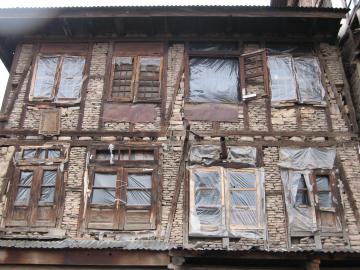
|
| Old town of Srinagar | Ruined house in Srinagar |
Beshir mentioned a carpet dealer, and I asked to see it. Carpet dealers don't have a good reputation among travelers, but I had been pricing Nepalese carpets recently and knew how to judge quality and price. I actually bought a small but top-quality carpet there for a good price, almost an order of magnitude less than you pay in Berlin, after endless negotiation and much tea. The dealer immediately wanted to sell me more carpets. (The carpet arrived with DHL at home without any trouble.)
Most people I met spoke English as a second language, and are eager to understand and explain. They tend to be very literal - when the boat rolled a bit at one point, I joked about earthquakes and got an earnest lecture on water waves.
26. The next day I went trekking. We drove up into the mountains with a jeep, first on regular streets and then on dirt paths, often perilously close to the edge of the cliff, at high speeds. At one point we had to stop because a small stone avalanche was coming down onto the street ahead of us, but we did not get hit. At one point the road was washed out but what remained was wide enough for us. The views of the Himalaya mountains and valleys is spectacular. There are many small villages with houses scattered on the hillside, and terraced green fields below snowy mountaintops.
At an altitude of 2200m, we arrived near a gypsy village (that name isn't used in Europe but here it is) named Naranagh. The houses are traditional, made of mud bricks and wood, sometimes with roofs made of corrugated metal. Paths here are very steep and muddy. We got served a small lunch, and then went riding on ponies deeper into the valley.

| 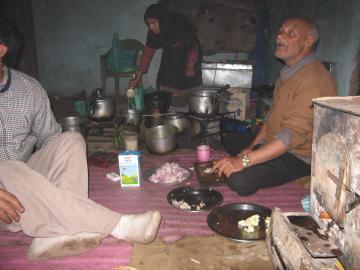
|
| Loggers returning in the Himalayas | Old man cooking dinner in the village |
I had never ridden a pony. It's similar to riding a camel but more agile. It was a little precarious at first when the ponies climbed up and down steep hills, but it doesn't take long to learn to anticipate and trust the pony and shift weight accordingly. The path was narrow and sometimes steep, with many boulders and patches of snow. The ponies handled it easily; I sometimes found it a little too close to deep chasms for comfort (ok, the jeep ride was worse). The path ran along a wide winding creek with many small rapids. In some places water ran down the mountain and small glaciers were feeding it. There are great views of the mountain peaks all around us. We saw a lot of snow that would have melted by summer.
Back at the hut we got a wonderful chicken dinner, cooked over an open gas stove right in the room. A wood stove kept the room warm (and smoky). There were three of us, an Italian, a Japanese, and me; and an old man who prepared the dinner. In the evening, blankets and sleeping bags were spread out on the floor, and we went to sleep early. The sanitary facilities defied all description so I won't describe them. Suffice it to say that there are advantages to being male.
27. We woke up in a black-and-white world. It was snowing, and we had the most amazing panorama of the surrounding mountains. The valley and the houses on the slopes, and all the trees on the near mountainsides, were capped with snow, and in the distance high peaks with glaciers were showing. Some low feathery clouds were drifting through the valley. There was only white snow, white sky, and black patches on the ground; no color.

| 
|
| View of the village in the snow | Hiking up a snowy hill |
Then it was back on the ponies, this time riding up the mountain. The path wound up along a stream into the forest, until it became so steep that we had to dismount and continue on foot. Last night's snow had made the path wet and hard to see. We made it up quite some distance, but then it started to snow again, first lightly and then harder. Visibility dropped sharply; we were now in a cloud. We had to turn back, and very carefully walked down the path that had become muddy and very slippery. It's a long way down from there. Altogether, the highest point we reached was less than 2500 meters above sea level.
The trip back to Srinagar was uneventful. At one time we got stopped by a group of people who had improvised a gate across the street and were demanding money, but our driver and guide could shout louder so we could pass for free. At the time we arrived, around 16:00, it had started raining heavily and wouldn't stop, so this was a fairly short day. Due to the weather, I don't feel I got the service that was supposed to come with the trek, and alternatives promised for this case didn't materialize because the owner was conveniently unavailable. But being in the mountains was still a wonderful and unique experience.
So I spent the late afternoon on the back porch of the houseboat, watching the stream of rowboats with their characteristic heart-shaped paddles ferry passengers and supplies between the houseboats, sometimes calling out to me to ask whether I'd like to buy something. I also watched eagles circling and airlifting fish out of the lake. I had never seen an eagle up close, they don't occur where I live.
28. The next morning I was brought to the airport. If you think that US security procedures are paranoid you should see this. After several army checkpoints, we got to one where the bags were x-rayed for the first time. You walk up a short stairway into an open room covered by a armored steel cubicle on one side. The guard in the cubicle has a Kalashnikov, and he points it straight at you. Loaded and armed no doubt, I didn't ask. About fifteen more soldiers watch from the outside. Unfortunately I have no pictures because photography is strictly forbidden, and I'd rather not pick a fight with the Indian army while they point a weapon at me.
There were several more x-ray checkpoints inside the airport. All baggage must be checked, and all electronic devices including all batteries. For some reason, cell phones are ok. Even my guidebook got its own carry-on security tag with several stamps on it. I got patted down four times. Then we went to identify our checked bags. I watched a British couple who wanted to bring a bag into the plane argue with eight soldiers for 45 minutes.
When the flight was called up, all the women and children got to
walk out onto the airfield first, then the men. Most men still got to
the plane first because there was yet another checkpoint outside with one
line for women and two for men. Since there was no fixed seat assignment,
everyone pushed hard. There were three large aircraft side by side on the
airfield, two military Antonov airforce transporters, one with running
engines, and our civilian airbus. They were busy loading the baggage
from little trolleys pulled by farm engines painted with airline
insignia. Cute. Then the soldiers shooed some stray dogs away and off we
went. From the air I could see that there is a huge army camp around the
airport, easily recognizable by the bright cheerful camouflage patterns
on the roofs of what must be over a hundred buildings. Military minds
at work I guess.
MANDAWA
At the Delhi airport I was met by Rajender Rawat, my driver. We got along very well; he was a treasure of travel tips, and a very safe driver. Safe driving is very important in the traffic chaos that is India. Rawat usually drives tourists in the "golden triangle": Delhi, Agra, and Jaipur; many people do this as packages of three nights and four days. Mine was much longer though. Get in touch with Rawat if you plan a tour like this; I highly recommend him. Say hello for me!
We got on the road to Mandawa right away. Road conditions were mostly excellent, but sometimes, especially in villages, we were on deeply rutted dirt roads. After it got dark, we got into a big thunderstorm, with lightning all around us and torrential rain. It got so bad that the dirt road were completely flooded in places, and the car threw up sheets of water left and right. I have no idea how my driver managed to see unlit tuk-tuks, people, and cows in this, especially since nobody turns off their high beams for oncoming traffic here.
The Heritage Mandawa hotel in Mandawa was an old haveli, meaning a private villa or palace. Many of them have been converted to hotels to pay for restoration and upkeep. The rooms are grouped in two courtyards, all with high ceilings and murals everywhere, and lots of ornamentation. Quite fancy. The beds are hard as bricks, but I slept well by stacking the other bed's mattress on mine.
1. Breakfast is served in the courtyard; toast, jam, eggs if you
want some, and tea. Here it's just tea bags, not the cinnamon and honey
tea in Kashmir. A hotel boy showed me around the old town for a while;
many more havelis here but most look dirty and poorly maintained, unlike
my hotel. One had completely fallen down, exposing the murals of the
interior rooms. There is a market not far from the hotel. Peacocks roam
freely in the town square.
BIKANER
We stopped a few times on the way to Bikaner to see interesting villages, and to rest. That's another great thing about traveling with a private car - trains don't stop and wait for you when you'd like to explore a market. At another rest stop I got the best chai (tea) I have ever had in my life, made by an old man with a prehistoric machine that he had to crank.
Finally, we got to Karni Mata Temple, the Rat Temple. It's a beautiful small marble temple, and it's crawling with holy rats that are considered reincarnations of people. There are bowls with milk and food, but rats run and perch everywhere. Not so many that you'd step on them, like in an Indiana Jones movie, but it's still a very creepy experience. There are little black pellets everywhere. You have to take off your shoes to enter.
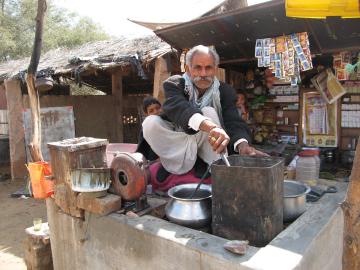
| 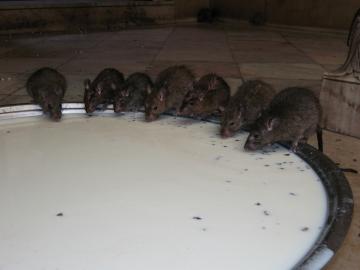
|
| Tea vendor on the road to Bikaner | Rats drinking from a milk bowl |
In Bikaner, there is a wonderful restaurant on the roof of the Harasar Haveli hotel, another tip by Rawat. The pineapple yoghurt here is great. I had the choice of staying at that hotel, and they showed me a big room with a huge bed, but I was put off by the mounted deer heads over the bed and the sitting room. I don't want the company of dead ornamental animals. So I stayed at the Raj Vilas Palace hotel instead, and got a nice spotless room.
Before night, we went out to the Bikaner fort, a gigantic red sandstone and marble palace that looks exactly like a Maharaja's palace is supposed to look like. It's a maze of courtyards, halls, and roofs. Guides are offering their service in crypto - someone talks at you and you assume it's English because he is looking at you, so you start processing and ten seconds later "ice owe jew blazes" suddenly turns into "I show you places" in your mind, and you shake your head.
Then I had some time in the old town, the usual chaos of honking vehicles, markets, and cows that slowly walk through the place as if they owned it. People sell fruits and vegetables off wheeled carts; there are bicycle repair shops with large stacks of tires, spice and nut vendors with racks of wicker baskets, open-air barber shops, clothing stores with their whole inventory pinned to the outside wall, chai stalls, a juice stall with a vicious-looking machine with big gears that turns meter-long sugar beets into juice, and countless others. Ad posters are often using strained English phrases like "live life non-stop" for a space heater. Well, yes, thanks, that's what I was planning to do.
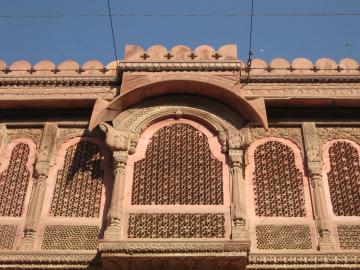
| 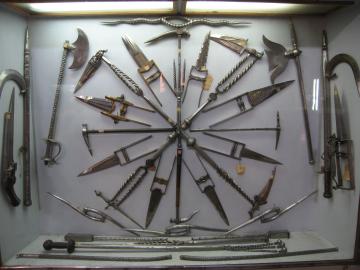
|
| Latticework windows at Bikaner Fort | Weapons display at Bikaner Fort |
There are lots of advertisement. Ads in Europe are mostly for lifestyle products that nobody really needs. In India ads are for things that people do need - mostly cement, although mobile phone providers are catching up. Ads for more expensive items like cell phone service tend to be in English. What you definitely won't find here are those nasty US chain stores like McDonald's, 7-Eleven, or Starbucks that pollute big cities in Asia.
The big thing in Bikaner is pictures, usually of animals or
traditional Hindu motifs, in needle-fine accuracy. I saw a picture
the size of half a postcard, of a tree with over 17,000 individually
painted leaves. They can put black dots so finely that the picture gets
an airbrushed look. They use only colored stones that they rub on marble,
mix with gummi arabicum, and water, and paint with superfine squirrel-hair
brushes on paper, silk, or sandalwood. True human ink-jet printers.
JAISALMER
2. It's a long drive from Bikaner to Jaisalmer (pronounced Jaisa-MIR), my next stop. The area gets more arid, there is a lot of sand and shrubs, and few trees. We stopped at a truck stop, a large thatched mud-brick house where tea is served. There are lots of children here that all want their pictures taken, and we are having a lot of fun. Children always ask for pens, usually ballpoint pens; seems to be a national hobby to collect them from tourists. Next time I'll bring a handful. When I got back into the car, they see my bag of oranges, and as I handed out oranges, a food frenzy starts with a dozen hands reaching inside the car to get the remaining oranges. Nice kids.
We had a great lunch at a roadside restaurant. The chicken curry and naan was great, but the lassi was a bit bland. As always, I could request mild food, because I don't like hot food. Overly spicy food was never a problem, anything can be ordered mild, and when they see a foreigner they assume mild by default. The restaurant had a nice awning outside in the garden. In Jaisalmer, we first stopped at my hotel, the Mahadan Palace. It's a kilometer away from the city gate, but looks very fancy and has a garden and a pool. After dropping my bag, we did some sightseeing.
First, two Jain temples, both some 15km outside the city. The Amarsagar temple is from an earlier time, before the capital was moved to Jaisalmer. It has been rebuilt a hundred years ago, and it looks it - most of the sandstone is perfectly shaped and not worn out. The carvings are intricate and beautiful. The temple sits at the edge of a lake, a rarity in this desert country. There are numerous little stone kiosks on small islands and at the shore.
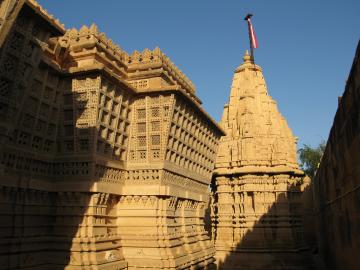
| 
|
| Jain temple | Carvings at Jaisalmer Fort |
The Ludarwa temple is older, some 600 years. It has a wonderful stone arch at the entrance, and it, too, manages to retain the fine detail of the sandstone carvings. They have a tree, carefully protected with a metal cage, that is said to be also 600 years old. If you have a question, like how to grow plants, you meditate under it and you know the answer. I want one of those for my office. A cobra lives under the temple, and it is fed daily with milk.
Finally, we drove up to the Dungari sunset point, which is just outside the city walls and provides a great view over the city and its fort. There are many small old stone kiosks dotting the ridge of the hill here. After sunset, I said goodnight to Rawat, and walked the city for some three hours, after listening to my driver's worried advice - but what can he do... The core of the city is its huge fort, where some 25% of the population lives. It is built on a hill and surrounded by a wall with 99 bastions. There are palaces, havelis, and all kinds of ancient buildings crowded close together. Many streets are so narrow that a cow walking it will block it. Some streets are lined with tourist shops, but others sell to the locals. It's a very big fort. There are many budget guesthouses here with great locations, although the accomodations seem very basic. I got back to the hotel late at night in a tuk-tuk, that famous three-wheeled Indian variety with lots of ornaments, and a two-stroke motor whose noise gave them their name.
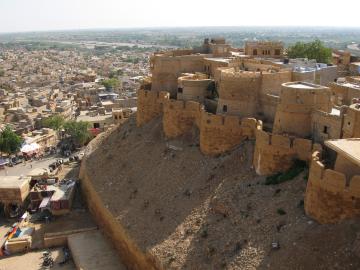
| 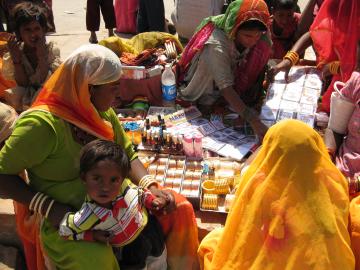
|
| Bastions of Jaisalmer Fort | Market in Jaisalmer |
3. In the morning, I went back to the fort with a guide. A guide was necessary on that day because it was the day of the Holi festival, which involves people throwing brightly colored paint dust and liquids at each other, and at unwary tourists. My guide was warning them off. This time I saw the palace, a huge afair with countless courtyards, passages, ballrooms, the Maharaja's favorite bedroom with blue dutch tiles and a low pillow-covered bed, and lots of little stairways and beautifully painted walls and views over the city and the fort. The whole fort seems like a maharadja's dream come true. There is a wonderful panoramic view from the top roof of the palace. Jaisalmer is called the Golden City because it's built from a local kind of sandstone that has a yellowish-golden hue.
We then wandered the narrow streets of the fort and surrounding city
for a while, and came to a group of five wonderfully ornate havelis. One
of them can be visited. It's unfurnished, and repairs after a 2001
earthquake were not finished, but it gives a great insight about how rich
people lived and conducted business. The lower floors do not receive much
light. From the top roof, there is an even better panorama over the city
than from the palace. They have lots of carved sandstone wall panels, thin
like finger, with countless holes cut in intricate patterns through the
wall so that most of the material is cut away. It's designed so that you can
look out but nobody can look in. It must take incredible skill to do that
with stone; sometimes I think we got too good at manipulating materials
to properly appreciate this. It's like laser-cutting in the 18th century.
DESERT
CAMEL
SAFARI
I had booked a camel safari into the desert. We were first driven to the edge of the desert in an old cramped jeep. There were four of us. Riding a camel is much like riding a pony except that there are no stirrups, so you sit wide-legged and very slowly develop a cramp. There is no danger of falling off, but it's a rather bumpy ride especially when the camel goes up or down a dune.
Eventually, after about three hours, we arrived at a small cluster of huts where we would spend the night. We got invited to a second, smaller cluster of huts where the family that owns them lives, with three sons and two daughters. We got served chai, and started playing with the children and chatting about life in the desert. As I write this, one of the boys has his face ten centimeters from mine, intently studying me typing on my PDA. I had to demonstrate my entire array of electronic equipment - PDA, GPS, cellphone, LED flashlight, and watch. He had great fun typing random text at a bash shell prompt that, unfortunately, didn't make much sense to the shell. Then he started drawing phone numbers into the sand to dial.
The huts are round rings of bricks, about 1.5 meters high, with a conical thatched roof. Each sleeps two people, but I opted to sleep outside. The have steel bed frames and lots of blankets, and I had brought a silk sleeping bag inlet. The wind can get a little chilly in the desert at night. We had a full moon that night, and after sunset the sky was studded with stars like it never is in Berlin.

| 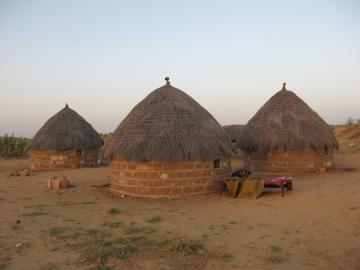
|
| Camel ride in the desert | Huts in the desert |
4. The next morning, I watched the sunrise, we got a small breakfast and chai, and then we got back on our camels again. Mine had somehow got some purple Holi paint sprayed on it. The ride was much shorter, and we were soon on our way back to Jaisalmer in the jeep. In Jaisalmer, Rawat was already waiting.
It was Sunday, and the second day of the Holi festival. I saw some
people covered in bright paint, including two Japanese tourists who
did not appear to have known what was happening. They are waylaying
tourists at the narrow entrance to the fort as well; the walls there
are splashed with color. Later, on the road outside the city, a line
of children across the highway were forcing us to slow down, and as we
passed them, they splashed paint over the car. I got the window rolled
up just in time. Later, after lunch at a roadside restaurant, a boy gave
me a little dab of color on the forehead.
JODHPUR
Close to Jodhpur, our destination for this day, we got stopped again by a band of red and purple men. These guys were more professional and carried sticks and made a lot of noise, all in good spirits. The driver paid a "ransom" and we could pass. In Jodhpur all the hotels are booked. I had a reservation but that hotel was far outside town, so we shopped around a little and found a room at the Haveli Guesthouse. It's a 250-year old heritage building. The room wasn't great (they had only one left), but the hotel has a restaurant on the roof that overlooks most of the city, and has a gorgeous view of the fort. There is a sign in the room warning that some rooftop restaurants in Jodhpur server poisoned food and when you get sick, they take you to a hospital where they earn a commission!

| 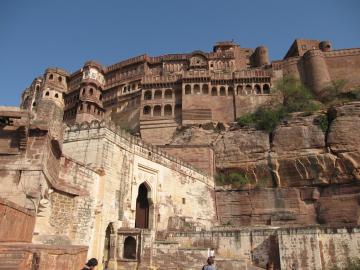
|
| Attack of the Holis | Entrance to the Jodhpur Fort |
The Jodhpur fort, like the Jaisalmer fort, sits on top of a hill, but it's higher and more forbidding. It lacks the enchanting fairy-tale charm of the Jaisalmer fort, but makes up for it with breathtaking heights crowned by a palace. The Jaisalmer fort is huge and contains a large portion of the city, but the Jodhpur fort consists of a palace and little else. The palace has many courtyards overlooked by intricately carved red sandstone facades. It's less playful than the Jaisalmer architecture; you basically expect the Maharaja strolling by any minute here.
The fort has great views over the city. If Jaisalmer is the golden city, then Jodhpur is the blue city. The majority of houses are painted bright blue. I didn't notice this so much from the streets, but when seen from the fort it becomes a magical sight. Noise was rising from the city like a cloud. I spent some two hours in the palace, listening to the excellent audio guide, and then went back to the city. The Holi festival was winding down; there were lots of purple people around and the streets were running with purple water, but nobody tried to spray paint on me.

| 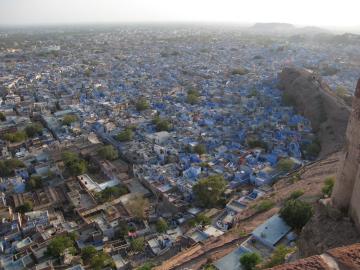
|
| Banquet hall in the Jodhpur fort | View of the Blue City from the Jodhpur fort |
After several hours of aimless walking, using the belltower as my landmark, I went back to the hotel. It was dark, the shops were closing, and after a while one street began to look like any other. Most streets are very narrow, not very clean, with mud-brick houses and narrow yards to the sides, and are connected with the usual tangle of cables strung haphazardly overhead.
I wear a balaclava to protect my head and neck from the sun. I was asked by a shopkeeper in the old town what my caste was, because he didn't recognize the shape and color of my "turban".
I concluded the day on the roof terrace of the Haveli Guesthouse,
watching the illuminated fort, and sipping a marsala (ginger) milk
tea. Great place. The next morning I had breakfast on that incredible
panorama roof again.
UDAIPUR
On the way to Udaipur, we stopped at the Ranakpur Jain temples. The Jain sect had two branches. One of them required that you could wear only a loincloth. The other was the same except no loincloth. Apparently there were no Jain pilgrims in today. The smaller of the two temples is marble with a frieze outside with large numbers of statues, some of which seem taken straight out of the Kamasutra. The larger temple is huge and airy, resting on countless marble columns with lots of light streaming in. You can get a photography permit but video is difficult: you get a guard who makes sure that you don't film idols, and you must record on VHS. Remember those? That's so twentieth century. They will keep the tape, edit out unwanted material, and mail the tape to you.
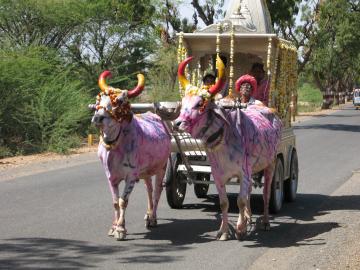
| 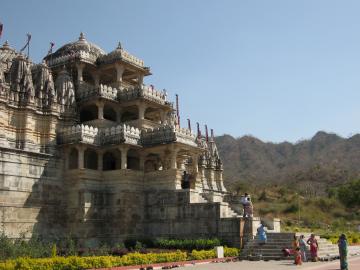
|
| Ox cart on the highway to Udaipur | Ranakpur Jain temple |
We finally arrived at the Rampratap Palace hotel in Udaipur, which was an actual Maharaja's home. It looked beautiful. But then I was told there is only one room left, which was a large but dark and musty ground-floor room behind the reception. After Rawat talked to the manager, I got that changed to a smaller room (26), but what a location! The new room was part of a little penthouse on the top terrace, with windows in three directions. The door led to a large terrace separated from the main public terrace, and the hotel gardens, the lake, and the mountains were all spread out before me! What a view. Just after me, more tourists arrived and were duly shown to their ground-floor rooms. Thanks Rawat!
6. The Udaipur palace can be toured with a combination ticket. I went to the crystal gallery first. This shows exactly the kind of opulence that one expects from a Maharaja: crystal chandeliers of course, but also sofas, tables, beds, and ornaments everywhere, all made mostly from glass. Plus endless shelves of glasses, goblins, and other tableware. Interesting, but not a must-see.
The palace museum is, more than the preceding fort palaces I had seen, a huge maze of fairly plain rooms, with several real gems. It's all linked with narrow twisty passages going up and down and around everywhere. It makes up for this by being fantastically huge. I think that doing the two-hour walking tour I haven't seen more than a small portion of this palace. There is no roof view.
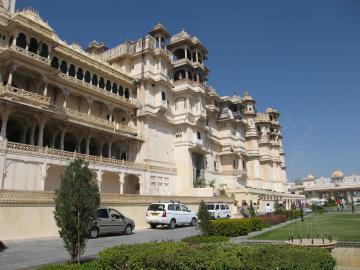
| 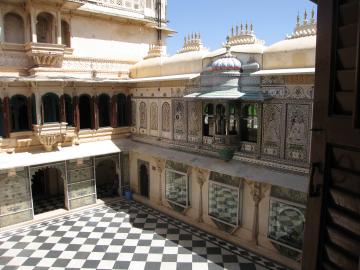
|
| Udaipur palace facade | Udaipur palace courtyard |
I also did a boat trip on the Lake Pichola, from a jetty right next to the palace. It does a big loop over the lake, and stops at the Jagmandir temple island for sightseeing and lunch. I skipped lunch. The big attraction of this lake is the Lake Palace, which completely covers a small Jagniwas island and is now a very expensive hotel. I don't know but to me it looks like an American motel transplanted onto pontoons, with various Indian accoutrements like ribbed window arches and little domes glued on. It's supposed to be fantastic inside; it's accessible only to guests. It was used in the James Bond movie Octopussy; they even have a junk parked outside except here it looks more like a barge.
I felt tired after all this and had an Ajurvedic massage at the oddly named New Look Beauty Point. It was incredibly relaxing and not at all like those brutal Thai massages, where people walk up and down on your back. Ajurvedic massages are based on stimulating pressure points on the body. On the way there the car got stuck in a wedding procession, consisting of hundreds of dancing people wearing brightly colored clothes, horses, and a few carts with huge speakers on top that were blaring Indian music.
Udaipur is also known as the white city. It's very clean, unlike
Jodhpur, where garbage piles are everywhere.
JAIPUR AND
AMBER
PALACE
7. It's a long drive to Jaipur, and since Udaipur is in a hilly area, we couldn't drive fast. The road was all curves up and down the mountains, with lots of slow trucks, and it had only two lanes. At one rest stop, a jeep stopped and suddenly the place was full of people. I thought that four passengers in our jeep in Jaisalmer was pretty crowded, but I counted fifteen passengers in this one! Later the road became a nice wide toll freeway.
Most days started early with a few hours of driving, leaving enough time to explore the destination in the afternoon. The drive from Udaipur to Jaipur is much longer, maybe twice as long, even though it doesn't look so bad on the map: eight hours! Sounds boring, but I was never bored driving. There are many small villages, at which we sometimes stopped, and just watching the other vehicles on the street is fascinating. There are buses with roofs full with people; small tuk-tuks so crowded that people hang off the back and the sides; camel carts carrying enormous hay bundles; large slow trucks painted all over; motorcycles with four people; ladies in bright colored saris walking with baskets balanced on their heads; children on bicycles - all sharing the same road.
Jaipur is a loud and busy city. Most of the hotels are to the west of the walled old town, and most are ugly modern affairs. I stayed at the Umaid Mahal, which is an old Haveli with lots of brass and silver and marble, and on a quiet side street. Quite nice; closer to the old city would be nicer but I have a car. It's my first hotel with WLAN access.
8. About 11km north of Jaipur there is Amber fort. It is built on the side of a hill, and is a castle like no other I had seen so far. It doesn't have the ornate Mughal architecture, and all the murals, ornaments, and interiors are lost, but it's a magical experience to walk this maze of a castle. There are little passages, rooms, bastions, winding stairs, towers, and courtyards everywhere. The tourist stampede just crowds a few highlights, but I looked at nearly every room. There is much to discover. In the bottom rear row of rooms I discovered holes broken into the wall that show that it's actually a double wall - some sort of ventilation system?

| 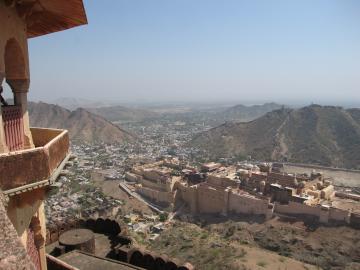
|
| Garden in Amber Fort | Amber Fort seen from Jaighar Fort |
Climbing down a little stairway tucked away in the rear right corner of the palace brought me to a path on top of the wall that encircles the hill. I followed it all the way to the top of the hill, which is covered by the Amber Fort Jaighar. From the top of its south tower, there is a fantastic view over the hills, the forts, and the city. And there were no tourists at all up here (later a few showed up). The fort is huge, with many dusty courtyards, but also a big garden at the north end. The views from there are spectacular. Amber including Jaighar is probably the most impressive fort I have seen so far. I took two hundred pictures in four hours there, including several 360-degree panoramas that I'll stitch into Quicktime VR scenes.
On the way back Rawat talked me into an elephant ride. I had done that twice before in the northern Thai mountains, but never on city streets. Cars gave us plenty of room. Back in town, I first went to the Hawa Mahal, also known as the Wind Palace, a graceful five-story palace, fairly narrow, designed for maximum window space with lots of little alcoves that allowed women to watch the street without being seen. The entrance is hidden away at the back. It has a tower with a great city panorama.
I also went to the city palace, a very well-maintained and spotlessly clean place because the Maharaja still lives here. This means that most of the palace is not accessible to visitors. They have some moderately interesting art and textile galleries, where the most interesting thing is the sign at the entrance that threatens that your film roll (what's that?) will be destroyed if you are caught taking pictures inside, and a weapons gallery. Those weapons turn bloodthirstyness into an art; there is stuff here that makes a Klingon battle saber look like a butter knife. One kind, called Katar, is a wide double-edged pointed blade held forward in your fist; some of these have the extra bonus feature that after you stick them into your opponent, they can scissor open. Another kind has one little gun barrel on each side. They also have guns with bores large enough to fire RPGs. Lovely place. No photographs allowed. Fully functional scissor Katars are also sold in tourist markets, might cause some irritation when found in carryon baggage.
Next I went to the Jantar Mantar, an 18th-century observatory. It consists mostly of large vertically curved sundials, except that they don't just track the sun; they have a separate one for each sign of the zodiac. They are made of stone and marble meticulously engraved with curves and scales. The gnomon of the largest is a stunning 27 meters high with a dainty hatted kiosk on top, and looks like a ski ramp.
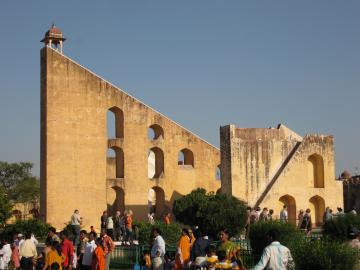
| 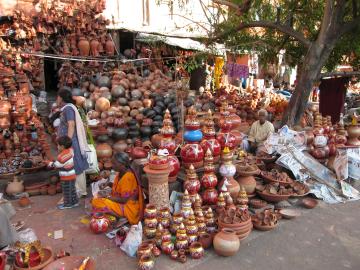
|
| Main sundial at Jantar Mantar observatory | Pots for sale |
I spent the remainder of the afternoon in the walled old town. To
complete the local color spectrum, it's called the pink city because all
buildings have the same pink color, or actually a reddish ochre. According
to Rawat, there is no brown or turquoise or other color city. Jaipur is
not as clean as Udaipur, but not anywhere as bad as Jodhpur. It's quite
pleasant to walk in the old town; traffic is bad but not the pure honking
madness found outside the walls. Distances are large, so I twice used
a bicycle rickshaw. These are clearly built for shorter people than me
but navigate city traffic quite efficiently. The official sign for "I'll
turn into oncoming traffic now, please don't kill me" is an outstretched
arm waving with the palm facing down. The absolute best Lassi I have
had on this tour was at the Lassiwala shop outside the walls; you get
it in a single-use earthen cup. I brought one home.
FATEHPUR
SIKRI
9. On the way to Agra we stopped at a tire repair shop where Rawat picked up a fixed tire. The tire shop consisted of a tricycle with a compressor mounted on the back, a bowl with water, and a cloth on the ground with tools carefully laid out on it. Looks very much like a bicycle repair shop except those don't need the compressor. Outside of Jaipur, we passed lots of stone works factory, receiving large blocks of stones and turning them into columns, latticework, and statues of gods and animals. They are using open motor saws for the rough cutting, and then workmen chisel out the ornaments and details. The clicking of chisels on stones went for kilometers.
Some trucks on the road are so overloaded that they are leaning dangerously, or overflow with huge bags that they look like zeppelins that crash-landed on a truck. Lunch was once again at a roadside restaurant. They all have the same layout: a hallway with toilets on one side and a large souvenir shop on the other, leading to a dining room with a snack rack at the entrance and a terrace at the rear.
| < prev | next > | |
Fatehpur Sikri was the capital of the Mughal emperor Akbar at the end of the 16th century, but only for 16 years when a severe drought forced them to move the government to Agra. The palace is built from dark red stone. It's laid out very orderly, and apart from some intricately carved pavilions there is not a lot of ornamentation. The place looks a little lifeless, as one might expect from a centrally planned city that was used only very briefly.
The guide touts are quite aggressive. Their spiel always begins with
the question "where are you from", and I enjoy derailing them right
there by naming a place they have never heard of. "Andorra" is one of
my favorites, and "Olympus Mons". The latter is on Mars but they don't
know that. It's all a game.
AGRA
In Agra I first dropped by bags at my hotel, the Mansingh Palace. It's close to the Taj Mahal; not so close to the old town. It's modern, clean, serves reasonable breakfast, but lacks atmosphere. Rawat then dropped me off at the Red Fort of Agra. It's mostly white marble with intricate carvings and many ornaments inlaid with semiprecious stones. But there are also red sandstone buildings that are pretty outside but in very poor conditions inside. The fort was the prison of Shah Jahan for eight years after his son dethroned him; he could sit on the terraces and look out to the Taj Mahal, the mausoleum that he built for his wife. Only 25% of the fort are open to the public, the rest is military.
After the sunset, I left the fort and wandered about the old
town. Some sections are quite nice with a large bazaar; others more
distant parts are unbelievably filthy. Not even cows go there.
TAJ
MAHAL
10. This was my last day in India, and I had kept one highlight for last. At six o'clock in the morning, I went to see the Taj Mahal, probably the best-known monument of all of India. The entrances lead to a formal four-quartered and walled Mughal garden. There is a large gate building on the north. From that gate, a narrow channel leads to the Taj Mahal, broken by two platforms. There are gardens to the left and right. Most Taj Mahal pictures catch the reflection of the Taj Mahal in the water. There are not very many tourists awaiting sunrise at this early hour, but they all stand together at the best viewing spots.
Sunrise is brief and the Taj Mahal is quickly in full sunlight. We had a little haze that softened the shadows, and made the marble that the Taj is built of glow softly, a truly magical view. I had seen many forts, castles, and palaces, and many are beautiful, but only the Taj Mahal is perfect. The marble is inlaid with semiprecious stones and other colored stones to form patterns and flower displays everywhere. The work is so accurate that after five centuries many gaps in the inlays are not visible and cannot be felt when running a finger over them. The Taj Mahal is completely symmetric.
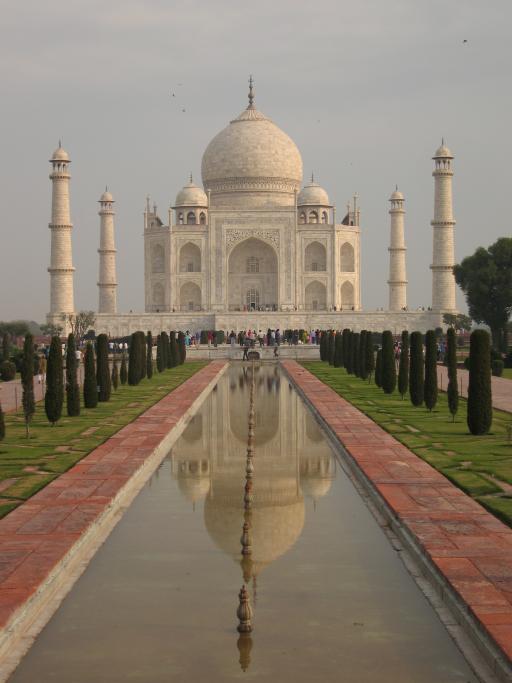
|
| The Taj Mahal at sunrise |
The inside is a large dome, all marble with the same inlay work, with a large octagonal marble wall in the middle that holds two sarcophagi for Shah Jahan and his wife. Since Shah Jahan built the Taj Mahal as a mausoleum for his wife, her sarcophagus is in the center; his is to one side but it's a little higher (rank hath its privileges). The bodies are actually buried outside the dome. The dome is unlit and fairly dark. It's large but not huge, you could pack several of them into St. Peter's in Rome.
Then it was finally time to return to Delhi. I had originally planned to take the train, as another Indian experience. But the fast trains all went at very inconvenient hours, and the slow train is, well, slow, so I took the car with Rawat. This also gave me the opportunity to see Sikandra Fort not far from Agra; another mausoleum built of sandstone and marble in a large well-tended park. The central building also has four little towers, but they look like smokestacks. After the Taj Mahal no other palace could impress me anymore.
I have deleted my flickr albums because I no longer trust US cloud services.
If you liked this report and would like to read my exotic travel guide, click here.